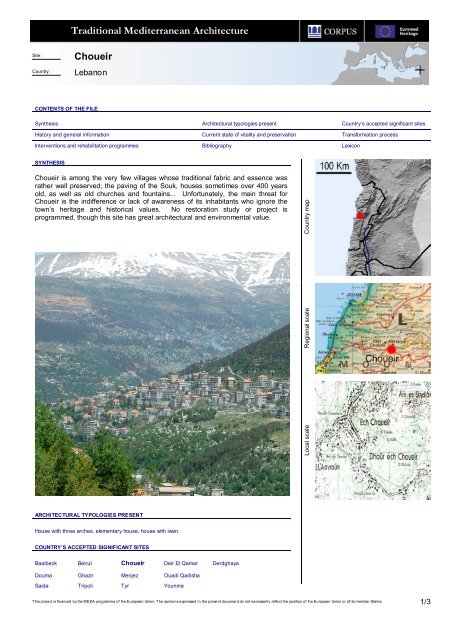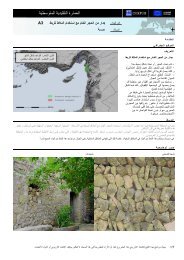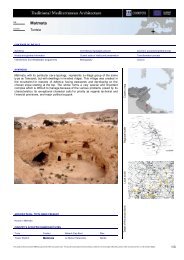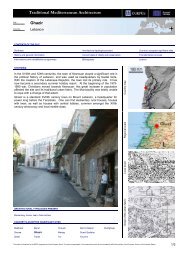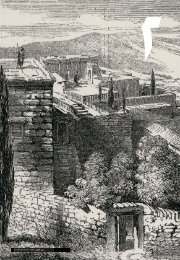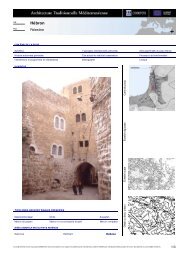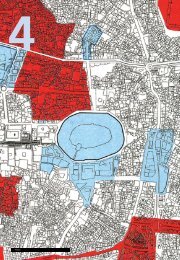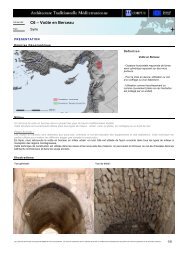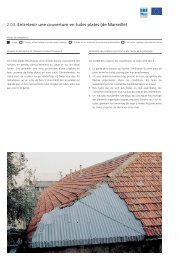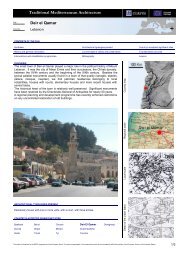Traditional Mediterranean Architecture - CORPUS - Euromed Heritage
Traditional Mediterranean Architecture - CORPUS - Euromed Heritage
Traditional Mediterranean Architecture - CORPUS - Euromed Heritage
Create successful ePaper yourself
Turn your PDF publications into a flip-book with our unique Google optimized e-Paper software.
<strong>Traditional</strong> <strong>Mediterranean</strong> <strong>Architecture</strong>Site :Country :ChoueirLebanonCONTENTS OF THE FILESynthesis Architectural typologies present Country’s accepted significant sitesHistory and general information Current state of vitality and preservation Transformation processInterventions and rehabilitation programmes Bibliography LexiconSYNTHESISChoueir is among the very few villages whose traditional fabric and essence wasrather well preserved; the paving of the Souk, houses sometimes over 400 yearsold, as well as old churches and fountains... Unfortunately, the main threat forChoueir is the indifference or lack of awareness of its inhabitants who ignore thetown’s heritage and historical values. No restoration study or project isprogrammed, though this site has great architectural and environmental value.Local scaleRegional scaleCountry mapARCHITECTURAL TYPOLOGIES PRESENTHouse with three arches, elementary house, house with iwan.COUNTRY’S ACCEPTED SIGNIFICANT SITESBaalbeck Beirut Choueir Deir El Qamar DerdghayaDouma Ghazir Menjez Ouadi QadishaSaida Tripoli Tyr YounineThis project is financed by the MEDA programme of the European Union. The opinions expressed in the present document do not necessarily reflect the position of the European Union or of its member States. 1/3
<strong>Traditional</strong> <strong>Mediterranean</strong> <strong>Architecture</strong>HISTORY AND GENERAL INFORMATIONThe name Choueir, in Arabic, is the diminutive form of Chir which means cliff, thus referring to the cliff sheltering the village. It is also a variationof the syriaque word “choro” which means wall, and further also evokes cliff.Various Roman vestiges or traces were found in the vicinity.Choueir developed after the Ottomans conquest of the area, as a consequence of their victories over the Mamelukes in 1517, when Sultan Selimconquered Egypt and Syria. The village, an orthodox majority, took part in the medieval political life of Mount Lebanon, opposing Emirs Kaysitesand Ymnites clans. The XXth century civil war was devastating: the town was located on the front line between High North Maten and Low NorthMaten. Choueir still hasn’t completely recovered from this war. Summer tourism is scarce and high unemployment plagues the village.⎯ Surface area of the site 3,78 km 2⎯ Geographical co-ordinates lat: 33º 55’ N; 35º 42’ E⎯ Height above sea level 700 to 1250m⎯LithologyLate Jurassic for the oldest layers.Sandstone with lignite (cretaceous base)or clayey sandstone (lower Apian) forintermediate layers⎯Population⎯ Population density 3.704 inhab/Km 2⎯ Average annual maximum temperatures 19,6°C14000 inhabitants (4000 locals and 10000from abroad, especially north America,south America and Australia)General View⎯ Average annual minimum temperatures 11°C⎯ Average of maximum temperaturesduring the hottest month for ten years⎯ Average of maximum temperaturesduring the coldest month for ten years37,8°C-7,5°C⎯ Average rainfall 1.270 mm⎯ Average number of days of rain per year 77 daysInside alleys⎯⎯⎯⎯Specific characteristicsRemarkable landscape, with inhabited cliff overhanging the whole locality<strong>Traditional</strong> economic activitiesFarming, silk, retail trade, craft industryNew economic activitiesRetail trade, small industries, hotel and restaurants. Majority of civil servantsSite’s communications with its territoryLocated 2km away from Dhour and Khenchara, Choueir belongs to the caza in Maten. Itis 28km away from Beirut.House with three archesThe old SoukThis project is financed by the MEDA programme of the European Union. The opinions expressed in the present document do not necessarily reflect the position of the European Union or of its member States. 2/3
<strong>Traditional</strong> <strong>Mediterranean</strong> <strong>Architecture</strong>CURRENT STATE OF VITALITY AND PRESERVATIONA great number of houses (approximately 100) are uninhabited today, and are thus in ratherpoor condition. <strong>Traditional</strong> constructions are generally disfigured by concrete add-ons andanarchistic transformations. Restorations are seldom valid. From an economic point of view,summer events and tourist activities improve the living conditions in Choueir. But, alas, thetown suffers from significant economic and architectural decline though the Municipality madeefforts in certain areas, like the little square and the cliff road...TRANSFORMATION PROCESSEmir FakhreddineII introduced silk trades and developed commerce. A gradual regressiondue to the end of silk industry and trade pushed inhabitants into exile.The second half of the XIXth century revived the villages of Mount Lebanon, amongst whichChoueir. Cultural and academic activities developed in Choueir under the impulse of severalChristian missions.The 1930s and 40s brought about a significant increase in summer tourism. Many middleclassEgyptians came to Choueir for summer holidays.From 1950 to 1970, most tourism came from countries in the Gulf.During the civil war (1975-1990), Dhour Choueir was on the front line, and the village waspartly destroyed. At the end of the war, a number of traditional houses were in ruins, whileothers were restored without following any adapted traditional techniques.Today, the Souk of Choueir has lost its commercial role: the stores on the ground floor areclosed and many first floors were transformed into dwellings. The causes for thistransformation are initially due to a decline of the textile industry and the arrival of readymadeurban products. A new main road now cuts through the village, putting the Souk on the fringeof town.Run-down houseINTERVENTIONS AND REHABILITATION PROGRAMMESMunicipality works are limited to widening roads or carrying out small drainage works. Nocomprehensive project was ever undertaken to promote, develop or really preserve the town.House with triple archContactsMunicipality of ChoueirAOUN Oula, architectRuins of an iwanBIBLIOGRAPHYRizkallah Milad, “Massayef al loubnaniyat : dalil el choueir wa nawahiha”, Tabbara, Beirut, 1923.Choueiri Raja, « Dhour el choueir ou la paix des pins », Phelix Bérythe, Beirut,1998.LEXICONFile created: 27.06.2003 Last modified: 06.12.2003This project is financed by the MEDA programme of the European Union. The opinions expressed in the present document do not necessarily reflect the position of the European Union or of its member States. 3/3


